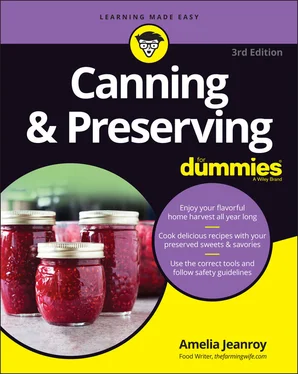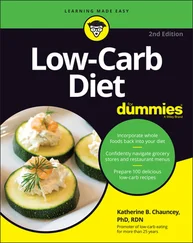Introducing Your Techniques: Canning, Freezing, and Dehydrating
The techniques discussed in this book are safe for home use and produce superior results when you follow all the steps for each method. You compromise the quality and safety of your food if you make your own rules. An example of this is shortening your processing period or not timing it correctly. Either of these adjustments can cause food spoilage because the food doesn’t heat long enough to destroy all of the microorganisms in it.
 Review the basic techniques for your type of food preserving before you begin — and if you’re already familiar with the techniques, review them annually just to refresh your memory. You’ll experience fewer interruptions in your food-preserving process. Always do a trial run before canning. This ensures you have all your supplies and steps in order so that you can work quickly and efficiently. Check out the “ Key Tricks to Successful Canning and Preserving” section later in this chapter for additional advice to ensure your first canning experience for the season is successful.
Review the basic techniques for your type of food preserving before you begin — and if you’re already familiar with the techniques, review them annually just to refresh your memory. You’ll experience fewer interruptions in your food-preserving process. Always do a trial run before canning. This ensures you have all your supplies and steps in order so that you can work quickly and efficiently. Check out the “ Key Tricks to Successful Canning and Preserving” section later in this chapter for additional advice to ensure your first canning experience for the season is successful.
You’ll have no doubts about preparing safe home-canned and home-preserved food after you discover what each method does, which method is best for different foods, the rules for the technique you choose, and safe food-handling techniques. The following pages introduce you to both ancient and modern-day techniques that will help you can and preserve with ease.
 Put by or putting up are terms that describe canning years ago, before there was refrigeration. They meant, “Save something perishable for use later when you’ll need it.”
Put by or putting up are terms that describe canning years ago, before there was refrigeration. They meant, “Save something perishable for use later when you’ll need it.”
Canning is the most popular preserving method used today. Don’t let anyone tell you that home-canning is complicated and unsafe. It’s simply not true. Canning is the process of applying heat to food that’s sealed in a jar in order to destroy any microorganisms that can cause food spoilage. All foods contain these microorganisms. Proper canning techniques stop this spoilage by heating the food for a specific period of time and killing these unwanted microorganisms. Also, during the canning process, air is driven from the jar, and a vacuum is formed as the jar cools and seals. This prevents microorganisms from entering and recontaminating the food.
Although you may hear of many canning methods, only two are approved by the United States Department of Agriculture (USDA). These are water-bath canning and pressure canning.
Water-bath canning: This method, sometimes referred to as hot water canning, uses a large kettle of boiling water. Filled jars are submerged in the water and heated to an internal temperature of 212 degrees for a specific period of time. Use this method for processing high-acid foods, such as fruit, as well as items made from fruit, pickles, pickled food, and tomatoes. Chapter 4explains this method in detail.
Pressure canning: Pressure canning uses a large kettle that produces steam in a locked compartment. The filled jars in the kettle reach an internal temperature of 240 degrees under a specific pressure (stated in pounds) that’s measured with a dial gauge or weighted gauge on the pressure-canner cover. You use a pressure canner for processing vegetables and other low-acid foods, such as meat, poultry, and fish. For more information about pressure canning, see Chapter 9. Don’t confuse a pressure canner with either a pressure cooker or an electric multi-cooker that includes a Canning button, both of which are used to cook food quickly. A pressure cooker does not have adequate room for both the canning jars and the water needed to create the right amount of pressure to preserve foods. At one time, manufacturers of some consumer pressure cookers stated that they were safe for pressure canning; however, they have since issued a correction and acknowledged that their pressure cookers cannot be used safely for pressure canning.
 In both water-bath canning and pressure canning, you heat your filled jars of food to a high temperature in order to destroy microorganisms and produce an airtight vacuum seal. The only way to reliably produce a safe canned product is to use the correct method for your type of food, follow your recipe instructions to the letter, and complete each processing step. For all the details you need about canning and a plethora of recipes, head to Parts 2and 3.
In both water-bath canning and pressure canning, you heat your filled jars of food to a high temperature in order to destroy microorganisms and produce an airtight vacuum seal. The only way to reliably produce a safe canned product is to use the correct method for your type of food, follow your recipe instructions to the letter, and complete each processing step. For all the details you need about canning and a plethora of recipes, head to Parts 2and 3.
Older canning methods are unreliable and, for that reason, aren’t used or recommended today for home-canning. Occasionally, these methods are “revived” as being faster and easier than water-bath or pressure canning, but using any of the following methods is like playing Russian roulette with your food safety. Just because your grandmother used one of the following methods doesn’t make it safe to use today. If you see instructions that require you to use any of the following methods, do yourself a favor and pass by that recipe.
Oven method: In this method, filled jars are placed in a hot oven. The method is unsafe because your food’s internal temperature most likely won’t become hot enough to destroy microorganisms and other bacteria that cause spoilage. There’s just no guarantee that the food in the jars will reach the temperature you set your oven at. There’s also a chance that your jars may explode from the sudden temperature change when your oven door is opened.
Dry canning: In this method, products such as flour and beans are placed in traditional canning jars and the jars are heated at a low temperature. The lids are applied either before heating or after the jars are removed from the oven. Heating dry goods in this manner is unsafe for two reasons. First, heating dry foods releases any moisture that is naturally still in the food. This moisture can develop mold, and other pathogens that are dangerous to ingest. Second, higher-fat foods such as nuts and grains will deteriorate more quickly after being subjected to heat. This deterioration causes the food to become rancid.
Open-kettle method: In this method, food is cooked in an open pot and transferred to sterilized jars. The two-piece caps are quickly added in hopes of sealing the jars as the food cools. This process produces a low vacuum seal that may be broken as gas from spoiling food builds up in the jar. This occurs because your food isn’t heated to destroy microorganisms. There’s also a chance your food may become contaminated when transferring it into the jars.
Steam method: This method uses a shallow, covered pan with a rack in the bottom. After the filled jars are placed in the pan, steam circulates around the jars. This method is unsafe because the jars aren’t evenly heated and the steam isn’t pressurized to superheat the food and destroy microorganisms. Don’t confuse this method with pressure canning.
Microwave oven: All microwave ovens heat differently. Because of this, there’s no way to set standards for processing times that achieve a high enough temperature to penetrate the jars and destroy microorganisms that cause food spoilage.
Dishwasher: Because there’s no way to know the exact temperature of different dishwashers and because temperature fluctuates throughout the cleaning cycle, dishwasher canning is a no-no. You can’t rely on it to produce a safely canned product. You can, however, use a dishwasher to wash your jars and let them sit in the hot dishwasher until you’re ready to fill them.
Читать дальше

 Review the basic techniques for your type of food preserving before you begin — and if you’re already familiar with the techniques, review them annually just to refresh your memory. You’ll experience fewer interruptions in your food-preserving process. Always do a trial run before canning. This ensures you have all your supplies and steps in order so that you can work quickly and efficiently. Check out the “ Key Tricks to Successful Canning and Preserving” section later in this chapter for additional advice to ensure your first canning experience for the season is successful.
Review the basic techniques for your type of food preserving before you begin — and if you’re already familiar with the techniques, review them annually just to refresh your memory. You’ll experience fewer interruptions in your food-preserving process. Always do a trial run before canning. This ensures you have all your supplies and steps in order so that you can work quickly and efficiently. Check out the “ Key Tricks to Successful Canning and Preserving” section later in this chapter for additional advice to ensure your first canning experience for the season is successful. Put by or putting up are terms that describe canning years ago, before there was refrigeration. They meant, “Save something perishable for use later when you’ll need it.”
Put by or putting up are terms that describe canning years ago, before there was refrigeration. They meant, “Save something perishable for use later when you’ll need it.”










